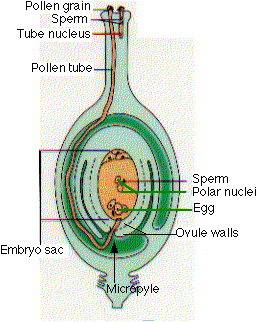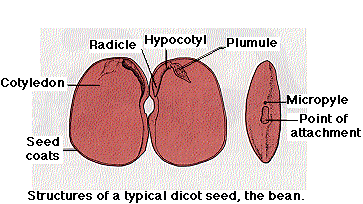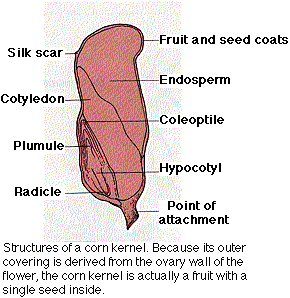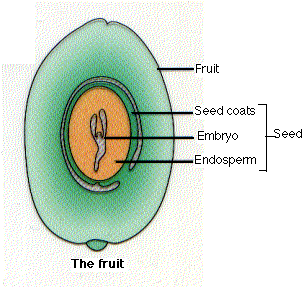| Index to this page |
Angiosperms are the flowering plants (today the most abundant and diverse plants on earth).
Most are terrestrial and all lack locomotion. This poses several problems.
The functions of the flower solve both of these problems.
In angiosperms, meiosis in the sporophyte generation produces two kinds of spores.
| Link to a discussion of the alternation of gametophyte and sporophyte generations |
Both types of sporangia are formed in flowers.
In most angiosperms, the flowers are perfect: each has both microsporangia and megasporangia.
Some angiosperms are imperfect, having either microsporangia or megasporangia but not both.

Flowers develop from flower buds. Each bud contains 4 concentric whorls of tissue. From the outer to the inner, these develop into
| Link to a discussion of the genetic control of flower formation. |
Each stamen consists of a
Meiosis of the diploid microspore mother cells in the anther produces four haploid microspores. Each of these develops into a two-celled pollen grain.
The two cells are the
Carpels consist of a
Often the entire whorl of carpels is fused into a single pistil.
The megasporangia, called ovules, develop within the ovary.
Meiosis of the megaspore mother cell in each ovule produces 4 haploid cells:
| Link to a view of the entire process. |

The nucleus of the megaspore undergoes 3 successive mitotic divisions. The 8 nuclei that result are distributed and partitioned off by cell walls to form the embryo sac. This is the mature female gametophyte generation.
When a pollen grain reaches the stigma, it germinates into a pollen tube. The generative nucleus divides by mitosis forming 2 sperm nuclei. These, along with the tube nucleus, migrate down the pollen tube as it grows through the style, the micropyle, and into the ovule chamber.
In Arabidopsis, at least, the pollen tube follows a gradient of increasing concentration of gamma amino butyric acid (GABA; the same molecule that serves as an important neurotransmitter in the human brain — Link). There is also evidence that a gradient of nitric oxide (NO) can guide pollen tubes to their destination [Link].
The pollen tube with its contents makes up the mature male gametophyte generation.

The development of each of the parts of the plant embryo depends on gradients of the plant hormone, auxin.

The food in the cotyledons is derived from the endosperm which, in turn, received it from the parent sporophyte. In many angiosperms (e.g., beans), when the seeds are mature, the endosperm has been totally consumed and its food transferred to the cotyledons. In others (some dicots and all monocots), the endosperm persists in the mature seed.
The seed is thus a dormant embryo sporophyte with stored food and protective coats. Its two functions are

Fruits are a development of the ovary wall and sometimes other flower parts as well. As seeds mature, they release the hormone auxin, which stimulates the wall of the ovary to develop into the fruit. In fact, commercial fruit growers may stimulate fruit development in nonpollinated flowers by applying synthetic auxin to the flower.
Fruits promote the dispersal of their content of seeds in a variety of ways.
| Welcome&Next Search |